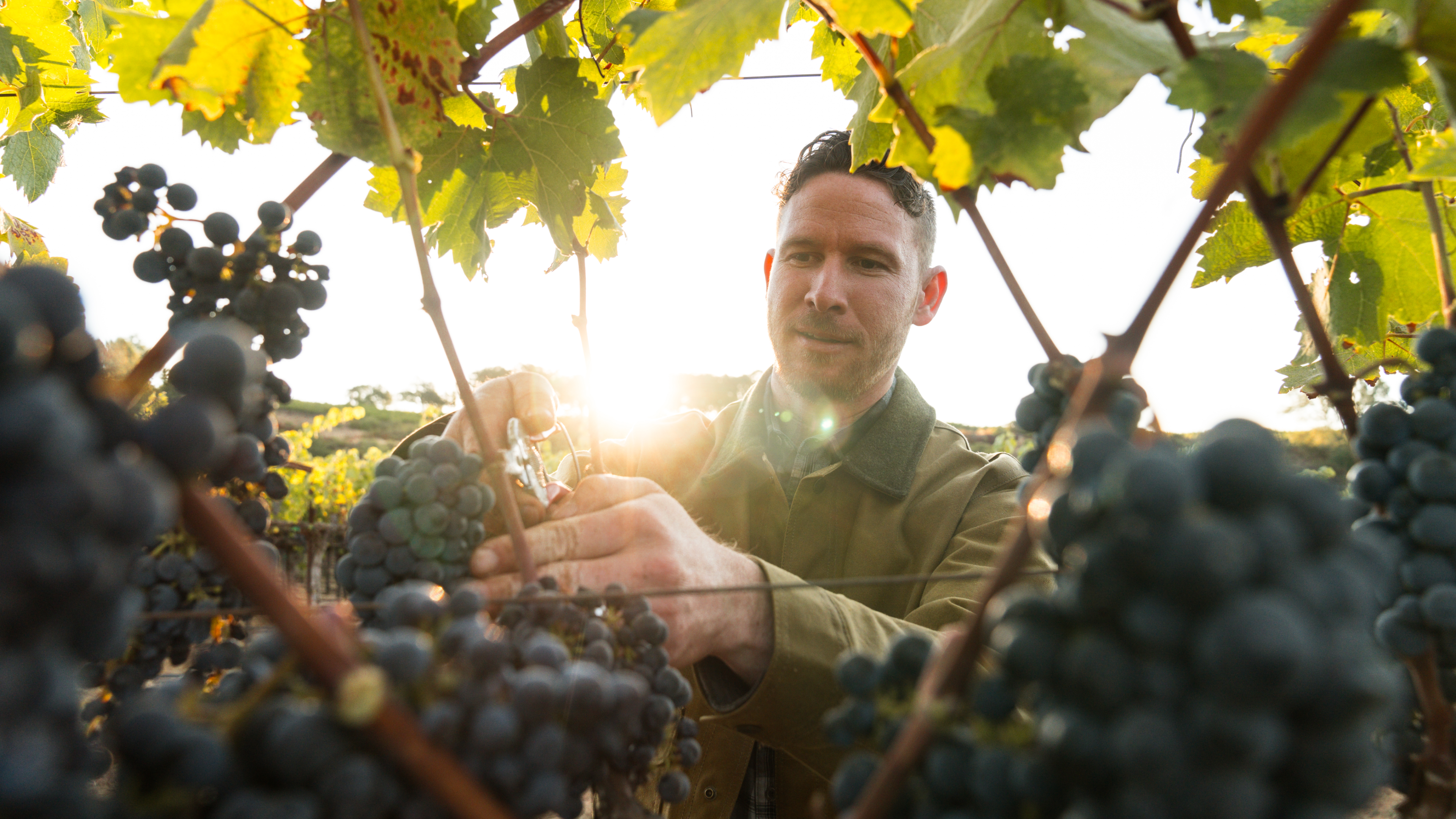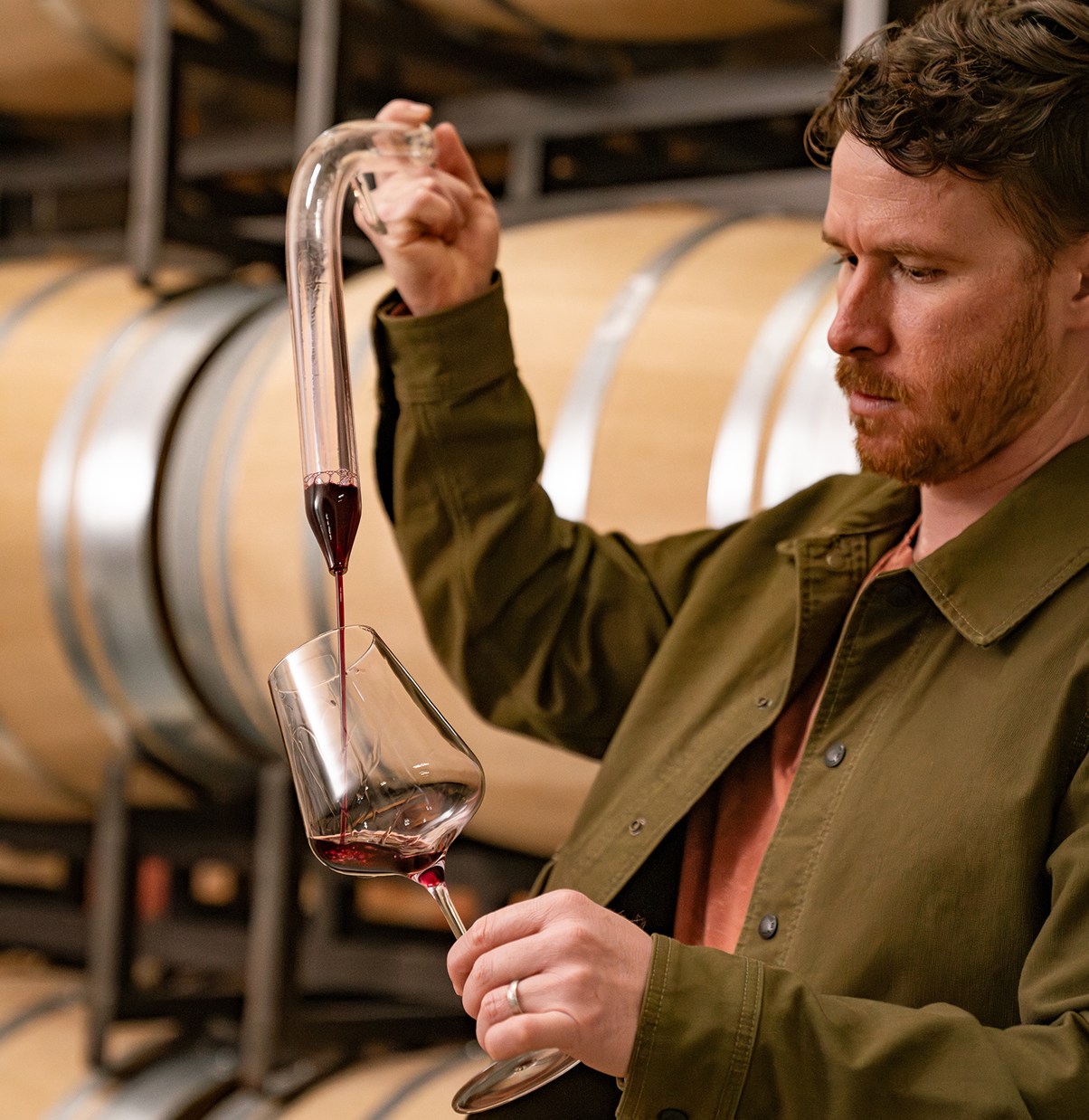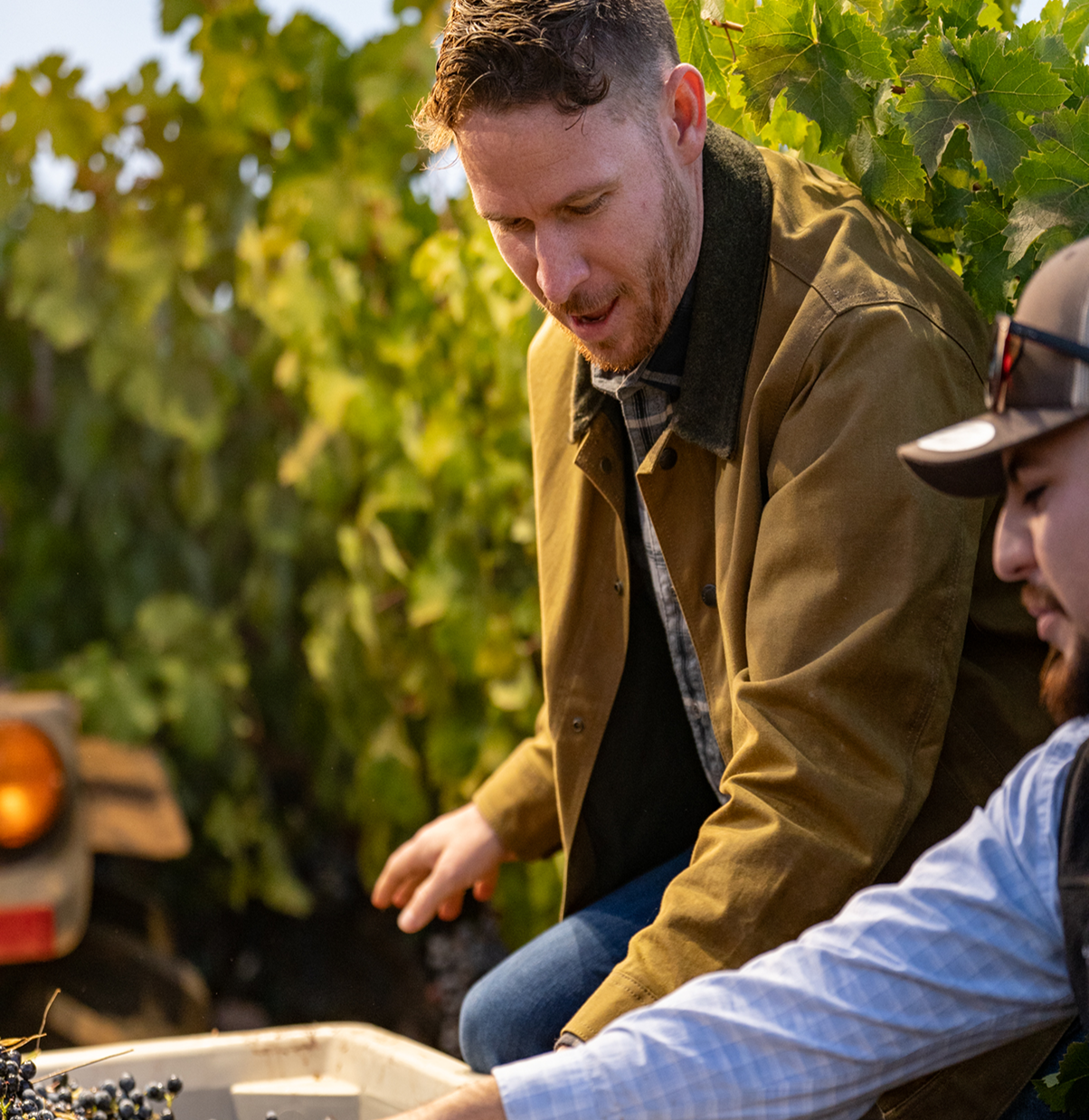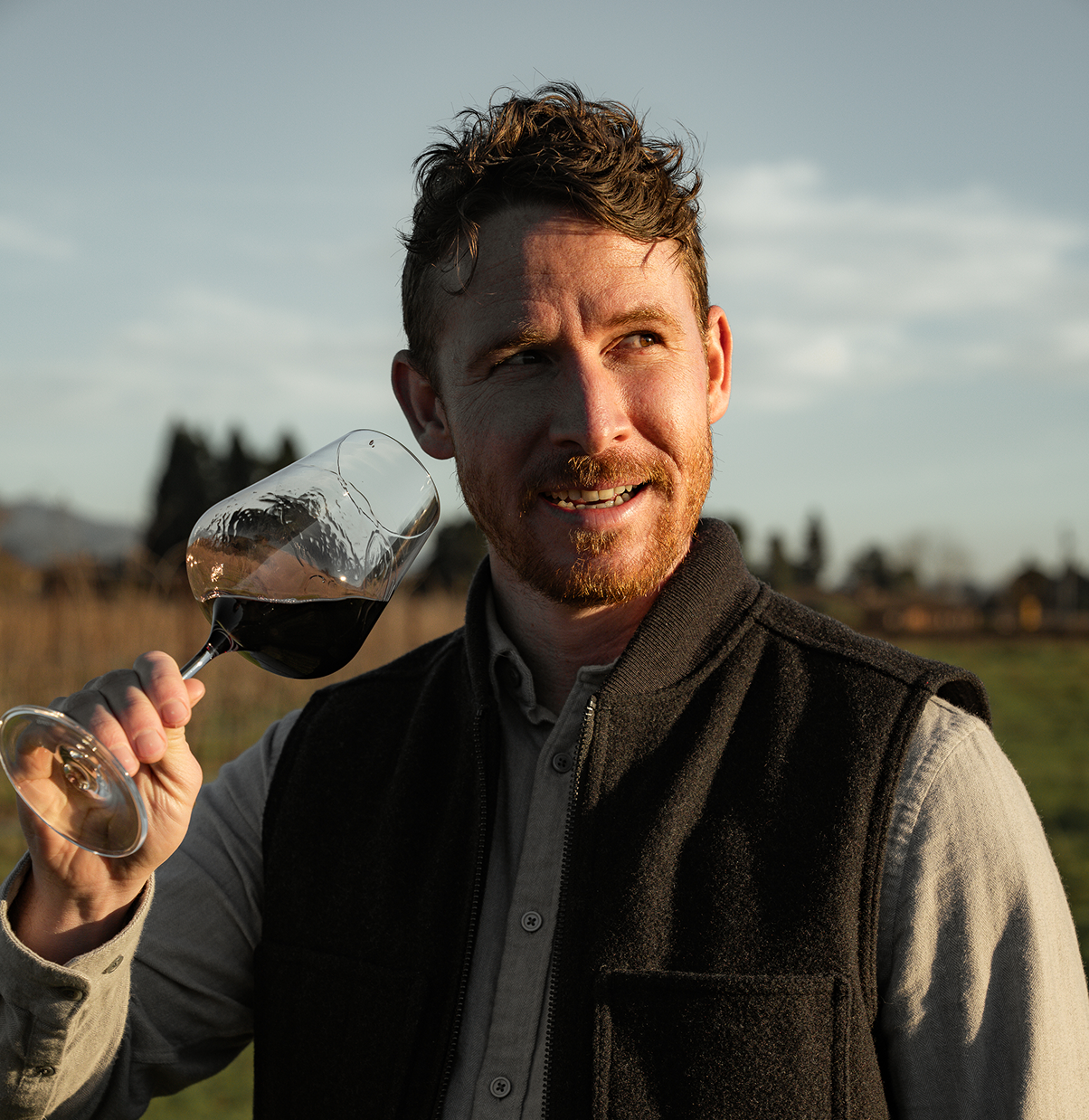
Zach Watkins, Winemaker
As winemaker for Louis M. Martini, Zach continues a long legacy of exceptional winemaking at this historic Napa Valley estate as he demonstrates his artistic ability for crafting wines that embody the perfect balance of tradition and modernity.
Zach’s father, a contractor, instilled in him an early appreciation for craftsmanship. The foundational value of “if you’re going to do it, do it right” was embedded in Zach from a young age, profoundly shaping his sense of self and the way he approaches his craft.
While studying microbiology at Cal Poly San Luis Obispo, Zach developed a fascination with fermentation and its products. Immersed in a renowned wine region, he pursued his passion by taking courses in wine and viticulture, working his first harvest, and continually refining his technical skills and deepening his understanding of the science and artistry of winemaking. After graduating, Zach set out on a journey to broaden his horizons and gain diverse experiences in the wine industry.
Now completing his fifth vintage with Martini, Zach brings over a decade of winemaking experience to his role. Respectful of the legacy he will continue to build at Martini, he is excited to add his own personality and creative lens to the portfolio. “My goal is to craft a collection of wines that lends itself to the holistic wine experience,” says Zach. “It’s an honor to continue working alongside the amazing team here as we work together to uphold the Martini winemaking standards that have spanned generations.” And although choosing a favorite wine depends on the time and place for Zach, he is most excited about the Monte Rosso Cabernet Franc followed closely by Mount Veeder Cabernet Sauvignon.
Zach’s enthusiasm for winemaking blends beautifully with his interests in the arts. He brings his past studies of philosophy, anthropology, ancient literature and art history into the vineyard. “When making Cabernet, I like to think about how the vineyard and the wine it creates relates to different classical art periods. There’s an emotional impression each vineyard conveys when walking through the vines. For example, Mount Veeder is certainly post-impressionism…Van Gogh comes to mind.”
Outside the winery, Zach can often be found exploring, camping and hiking untouched landscapes, while his at-home life is busy with DIY renovations and creating a farm-to-table lifestyle by raising chickens and lambs. He also enjoys the precision of archery, a practice that fosters an enticing internal competition for him.



Q&A with Zach
We sat down with our winemaker and did a candid Q&A to get a behind-the-scenes look at the craft, passion and personality that shape every bottle.
1. How does this 2025 vintage compare to previous years?
Each growing season, my mind always goes to two things: winter rains and peak heat days. It’s the collaboration between lush vegetative growth from those early rain events and the steady buildup of heat that lays the foundation for success before veraison. Once veraison hits, it’s all about temperature—the heat drives the development of color and fragrance that define the vintage. This year, Napa’s seen generous winter rains and a beautifully slow, steady growing season, setting the stage for an exceptional veraison and what’s shaping up to be a standout vintage.
2. What’s the most important decision you make during harvest?
Harvest is full of critical details—on both the growing and winemaking sides—and to me, they’re deeply connected. At the heart of it all is the pick decision. That single choice sets the tone for the entire wine, defining its style, structure, and expression. For me, timing the pick just right is everything. It’s the most impactful decision we make.
3. What’s one part of the winemaking process people might not realize is so hands-on?
In the world of fine wine, everything is incredibly hands-on. The vineyards we work with are often so remote or rugged that machines simply aren’t an option—so every step, from pruning to picking, is done by hand. At the winery, it’s the same story: hand-sorting, hand punch-downs, hand pump-overs. I love that. To me, what makes it true craftsmanship isn’t the process itself, but the quality of the fruit and the human touch behind every decision.
4. Is there a grape or vineyard that you’re particularly excited about this year? Why?
At the end of the day, Cabernet is where I have the most fun—it’s the variety that excites me the most. We work with so many unique parcels, each offering something different. What keeps it especially interesting are the challenges that come with certain sites. Take Stagecoach, for example—it’s incredibly dry and tough to farm, but the fruit it produces can be both powerful and surprisingly graceful. That’s what makes it a standout for me this year. It’s my problem to solve, and I’m fully engaged in crafting the best possible expression from that vineyard.
5. Do you make any different choices in the cellar based on when the grapes are picked?
Absolutely—on a holistic level, my approach is to match cellar practices to the vineyard itself. What I do with Stagecoach is different from what I do with Mount Veeder or Coombsville, because each site has its own personality. The goal is to bring out those unique characteristics, not force them into the same mold. That means adjusting techniques based on the fruit—things like tannin structure and aromatic intensity evolve over time, so the way we handle them evolves too. Generally speaking, an earlier pick tends to produce a more delicate, pretty wine, so I’ll lean into techniques that preserve that elegance. With riper, denser fruit, I shift toward methods that enhance richness and power. It’s all about responding to what the vineyard gives you.
6. How do you decide the right moment to pick?
Picking is one of the most critical moments in the entire winemaking process because it defines the wine’s flavor profile and tannin structure. There are tangible metrics—acidity, sugar levels, berry texture, seed color—that help establish a baseline, but at the end of the day, the decision is mostly driven by intuition. Calling a pick is less science and more art. It’s about reading the vineyard, trusting your instincts, and pushing through the emotion and uncertainty that comes with making such a pivotal call. Those metrics inform the moment, but they don’t dictate it—and that’s what makes it both the most artistic and the most nerve-wracking part of the process.
7. What are you looking for during fermentation that tells you the wine is on track?
It takes time to truly understand the trajectory of a high-quality wine—especially because during fermentation, it tastes nothing like the finished product. For me, it wasn’t until five or six years into the industry that I began to connect the dots between the early fermentation flavors and how the wine would ultimately classify in the spring. Once you develop that skill, you start looking for key indicators: clean aromatics, a strong fermentation rate, minimal off-notes (which tells you the yeast are happy and healthy), and intensity of flavor. When all of those elements come together, it’s a good sign you’re on the right track.
8. How do weather and climate impact your approach each harvest?
In any given year, weather plays a huge role in shaping the logistics and timing of harvest—whether it’s rain, heat, or, more recently, fire. In the past few vintages, extreme heat has been the dominant factor. Since heat drives ripening and flavor development, I tend to pick earlier in hotter years to preserve freshness and keep the grape’s phenolic maturity within an ideal window. In cooler seasons, the slower ripening process allows for a later pick, giving the fruit time to develop more complexity. That’s why staying in tune with growing conditions—especially water availability in the vineyard—is so important. I rely on past vintages to help benchmark decisions, but I also look at the 10-day forecast for every growing region, every single day post-veraison. It’s all about timing, and timing starts with understanding what the vineyard is experiencing in real time.
9. What winemaking choices do you make that define your style?
My perspective bridges both Old World tradition and New World innovation. I cut my teeth drinking classic wines from Alsace, Brunello, and Barolo—wines with structure, restraint, and a deep sense of place. I try to bring elements of that philosophy into my approach here in Napa. It influences everything from picking decisions to fermentation techniques. My goal is to craft wines that carry a distinct Napa identity but are layered with a subtle Old World elegance. I pay close attention to fermentation temperature, oak selection—including size and type—and every detail that helps shape the final style. It’s that balance between place, precision, and perspective that defines my approach today.
10. What’s one wine you’re most excited to share from this vintage? Why?
Last year, we experimented with some new techniques on our old vine Semillon from Monte Rosso—and while it came with a bit of risk, the results were incredible. The wine developed this beautiful core of minerality, layered with flinty, sea breeze aromatics that gave it a truly awe-inspiring expression. It’s a unique, almost ethereal take on Semillon, and I’m excited to revisit those same cellar techniques in 2025 to see if we can capture that magic again. It’ll be a while before this wine is released, but I’m looking forward to watching it evolve—especially knowing it’s made from such historic, storied vines.

